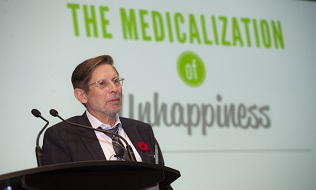

At $45 million per year, antidepressant claims are “the biggest spend in our drug portfolio,” Peter Gove, health innovation leader at Green Shield Canada, told Benefits Canada’s Mental Health Summit in Toronto.
The insurer looked at 36,000 claimants who had newly started on antidepressant medication. The data showed that 15 per cent of the claimants followed the typical treatment guidelines. “With the other, say, 80 per cent to 85 per cent, what we saw were extremely low doses, dropouts, no second fills and durations of treatment that were shorter than you would expect to have any outcome at all,” said Gove.
When Green Shield conferred with senior clinicians on the findings, one of the concerns expressed was that many people are probably receiving antidepressants for what amounts to life problems, he told the audience. “We wondered if we’re beginning to capture too many people in this net and we’re tending to apply a medication intervention to people who really need something else.”
Read: Integrated programs key to successful workplace mental-health strategies
In looking at depression specifically, Gove said a number of studies suggest the prevalence of depression in the population hasn’t changed in years. “What we have seen, though, is a dramatic increase in rates of diagnosis of depression.”
What are the factors that have helped increase the rates of diagnosis?
One influence, Gove suggested, could have been the mass promotion of new antidepressants that came onto the market in the early 1990s. The rates of prescribing those medications doubled in Britain between 1998 and 2010. In the United States, 11 per cent of the population at any one time is being prescribed an antidepressant. Canada also ranks as a big consumer of antidepressants among Organisation for Economic Co-operation and Development countries.
Read: Employers urged to make it easier to discuss mental health at work
Gove also pointed to a number of studies. In the Baltimore epidemiologic catchment area study, researchers reviewed clinician charts to look for indications of why medications were prescribed. They discovered that in a large majority of cases, antidepressants were prescribed in the absence of indications for depression.
In another study, 47,000 people were evaluated with a psychometric instrument for signs and symptoms of depression. It then categorized them into two groups: those receiving and those not receiving treatment for depression. Of those receiving treatment, less than 30 per cent were actually screened for depression.
“We’re not suggesting that antidepressant treatment is inappropriate,” said Gove.
“What we’re saying is that we have to be much more selective in how we capture the populations that require this kind of treatment.”
